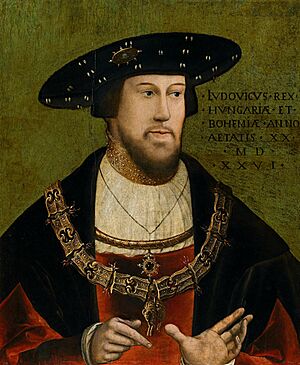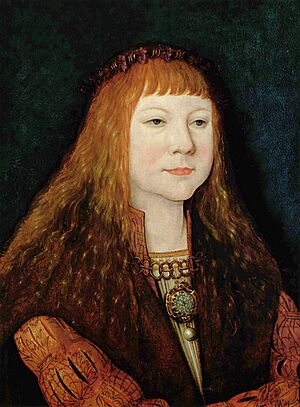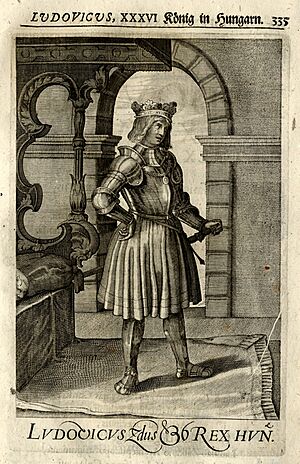Louis II of Hungary facts for kids
Quick facts for kids Louis II |
|
|---|---|

Portrait by Hans Krell, 1526
|
|
| King of Hungary and Croatia | |
| Reign | 1516–1526 |
| Coronation | 4 June 1508 |
| Predecessor | Vladislaus II |
| Successor | Ferdinand I John Zápolya |
| King of Bohemia | |
| Reign | 1516–1526 |
| Coronation | 11 March 1509 |
| Predecessor | Vladislaus II |
| Successor | Ferdinand I |
| Born | 1 July 1506 Buda, Kingdom of Hungary (now Budapest, Hungary) |
| Died | 29 August 1526 (aged 20) Mohács, Kingdom of Hungary |
| Burial | Székesfehérvár Cathedral |
| Spouse | Mary of Austria |
| Issue | Janos Wass (illegitimate) |
| House | Jagiellon |
| Father | Vladislaus II of Bohemia and Hungary |
| Mother | Anne of Foix-Candale |
| Religion | Catholic Church |
| Signature |  |
Louis II (born July 1, 1506 – died August 29, 1526) was the King of Hungary, Croatia, and Bohemia. He ruled from 1516 until his death in 1526. Louis II died during the important Battle of Mohács while fighting against the Ottomans. This battle led to the Ottomans taking control of large parts of Hungary.
Louis II's Early Life
Louis II was born early in Buda on July 1, 1506. Doctors worked hard to keep him alive by using special methods, like wrapping him in warm animal skins. This was a very early way to keep tiny babies warm. He was the only son of Vladislaus II from the Jagiellon dynasty and his third wife, Anne of Foix-Candale.
Becoming King: Coronations
His father, King Vladislaus II, wanted to make sure Louis would become king easily. So, Louis was crowned king while his father was still alive. Louis was crowned king of Hungary on June 4, 1508, in Székesfehérvár Basilica. He was crowned king of Bohemia on March 11, 1509, in St. Vitus Cathedral in Prague.
King of Hungary and Croatia
In 1515, Louis II married Mary of Austria. She was the granddaughter of Emperor Maximilian I. This marriage was part of an agreement made at the First Congress of Vienna in 1515. Louis's sister, Anne, married Mary's brother, Ferdinand. Ferdinand later became Emperor Ferdinand I.
For most of his time as king, Louis was often controlled by powerful nobles (called 'magnates'). He was so poor sometimes that he had to sell his valuable jewels just to buy food and clothes. His guardians, Cardinal Tamás Bakócz and Count George Brandenburg-Ansbach, didn't take good care of him. They wasted the kingdom's money and caused many arguments, which made things difficult for the country. Things got even worse when Cardinal Bakócz died. Then, the nobles István Báthory, John Zápolya, and István Werbőczy fought fiercely among themselves.
King of Bohemia
As king of Bohemia, Louis was sometimes called "Ludovicus the Child." The first thaler coins were made during his rule in Bohemia. These coins later gave their name to the "dollar" used in many countries today. The coins correctly called him "Louis the First, by the grace of God King of Bohemia."
War Against the Ottoman Empire
After his father died in 1516, the young Louis II became king of Hungary and Croatia. Louis was adopted by the Holy Roman Emperor Maximilian I in 1515. When Maximilian I died in 1519, Louis's cousin, George, Margrave of Brandenburg-Ansbach, became his official guardian.
When Suleiman I became the leader of the Ottoman Empire, he sent an ambassador to Louis II. The ambassador came to collect a yearly payment that Hungary was supposed to give to the Ottomans. Louis refused to pay. Some stories say he even had the ambassador killed, but there is no proof of this. Instead, the ambassador was kept waiting for years in Buda, almost like a prisoner. This was revenge for what Suleiman's father had done to a Hungarian envoy years before. Louis believed that the Papal States and other Christian countries, including Charles V, Holy Roman Emperor, would help him. This situation made Hungary's problems worse.
By 1520, Hungary was in a state of disorder because of the powerful nobles. The king's money situation was very bad. He had to borrow money just to pay for his household expenses, even though these costs were about one-third of the country's income. The country's defenses became weak. Border guards were not paid, and fortresses fell apart. Plans to raise taxes to fix defenses were stopped. In 1521, Sultan Suleiman the Magnificent knew how weak Hungary was.
The Ottoman Empire declared war on Hungary. Suleiman decided to attack Belgrade first. Louis and his wife Mary asked other European countries for military help. His uncle, King Sigismund of Poland, and his brother-in-law, Archduke Ferdinand, were willing to help. Ferdinand sent 3,000 foot soldiers and some cannons. Sigismund promised to send more soldiers. However, the plan to work together failed completely. Mary was a strong leader, but people didn't trust her because she relied on non-Hungarian advisors. Louis lacked energy, and his nobles noticed this. The help from Austria, even though it seemed to make the border stronger, actually made it harder for the Hungarian leaders to work together.
Belgrade and many important castles in Serbia were captured by the Ottomans. This was terrible for Louis's kingdom. Without the key cities of Belgrade and Šabac, Hungary, including its capital Buda, was open to more Ottoman attacks.
After attacking Rhodes, Suleiman launched a second attack in 1526 to take over all of Hungary. Around mid-July, the young King Louis left Buda. He was determined to "either fight back the invaders or be crushed once and for all." Louis made a mistake by trying to stop the Ottoman army in an open field battle. His army was from the Middle Ages, with not enough firearms and old ways of fighting.
On August 29, 1526, Louis led his forces against Suleiman in the terrible Battle of Mohács. The Hungarian army was surrounded by Ottoman cavalry. In the center, the Hungarian heavy knights and foot soldiers were pushed back and suffered many losses. This was especially due to the well-placed Ottoman cannons and skilled Janissary musketeers.
Almost the entire Hungarian Royal army was destroyed in about two hours. During the retreat, the twenty-year-old king died. He fell backward off his horse while trying to ride up a steep ravine of the Csele stream. He fell into the stream, and because of the heavy weight of his armor, he could not get up and drowned. Suleiman the Magnificent felt sad about the death of his young enemy. When he saw King Louis's body, the Sultan is said to have said, "I came to fight him, but I did not wish for him to die before he had barely enjoyed life and being king."
After Louis's death, Ferdinand (who was married to Louis's sister Anna) tried to claim the crowns of Bohemia and Hungary. His claim for Hungary divided the nobles. Most of them chose John Zápolya as king. This split later caused most of Hungary to be ruled by the Ottomans.
Louis II's Family and Legacy
Even though Louis II's marriage did not result in children, he likely had a son with his mother's former lady-in-waiting, Angelitha Wass. This son was named John (János in Hungarian). This name appears in records in Vienna as either János Wass or János Lanthos. The first name is his mother's family name. The second name might refer to his job, as "Lanthos" means "lutenist" or "bard" (someone who plays a lute). He regularly received money from the Royal Treasury and had his own children.
Remembering Louis II
North of the town of Mohacs, there is a 5-meter-high monument to remember Louis II. It is located near where Louis died at the Csele Stream. On the monument, there is a bronze plaque that shows Louis falling off his horse. On top of the monument, there is a figure of a sleeping lion. Soma Turcsányi, a Hussar lieutenant, paid for the first monument in 1864. It was rebuilt in 1897 and restored by the local government in 1986.
Images for kids
See also
 In Spanish: Luis II de Hungría para niños
In Spanish: Luis II de Hungría para niños





